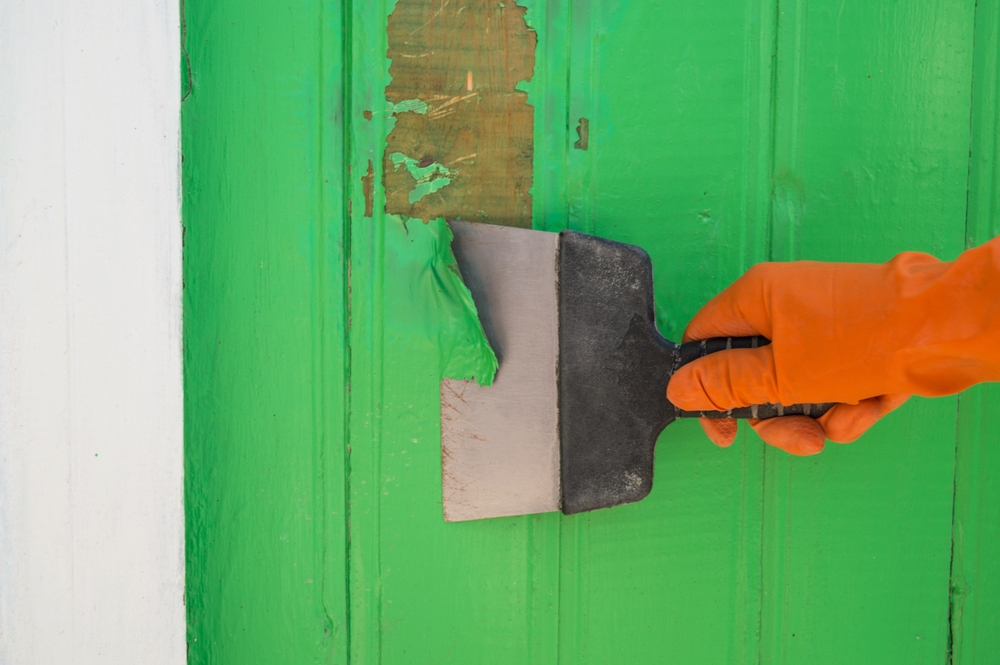How to Remove Paint from Metal Safely? 7 Methods You Can Use at Home

Got an old metal gate or vintage chairs covered in layers of stubborn paint?
You want to repaint, refresh, or reveal the shiny glory underneath. But the old layers of paint are putting up a serious fight. It’s chipped. It’s flaking. But stick to the core as applied with glue and spite. Right?
Well, you’re in luck. Because at Final Touch Paint & Decor, we’ve battled more stubborn paint than we can count, and won. From chilled-out garden chairs to big-shot business facades in Perth, we handled with every type of paint.
So, let us teach you a thing or two (or seven) about getting paint off metal like a boss.
Getting Ready to Remove Paint from Metal: Preparation Tips
Before you start stripping paint off metal, make sure that the surface id prepared for it. Also, double check that you have everything needed for the process & safety equipment from hazards.
Here are some essential preparation steps you should keep in mind.
1. Safety Comes First
Removing paint from metal is a messy, smelly, and even a bit hazardous process.
You’ll need:
- Safety gloves to protect your hands from chemicals and sharp tools.
- Safety goggles to shield your eyes from paint flakes and fumes.
- A good-quality mask or respirator if you’re using solvents or generating dust.
- Clothes you don’t mind ruining.
2. Choose a Well-Ventilated Space
Work outdoors if you can. If not, make sure you’re in a well-ventilated garage or workshop. Fumes from chemical paint strippers and airborne dust from sanding can be harmful. If you have any respiratory condition then we’ll recommend not to do it on your own.
3. Gather the Right Tools
Depending on the method you choose, you’ll need:
- A paint stripper for metal
- Wire brushes or scrapers
- Sandpaper or sanding discs
- A heat gun
- White vinegar or baking soda
- Buckets, cloths, and clean water
4. Do a Patch Test
Whatever method you choose, test it on a small section of the metal item. Some techniques work better on certain types of metal. So, a patch test will help you test the efficiency of method and avoid any potential damage.
Methods to Remove Paint from Metal Surfaces
Now coming toward the real concern “how to strip paint off metal?” There are several methods to remove paint from metal surfaces. We’ve tried and tested them all & can vouch for their successful execution.
Let’s spill everything we learned one by one.
Method 1: Chemical Paint Stripper for Thick Layers
Using a chemical paint stripper for metal is the quickest ways to deal with multiple layers of paint, especially on detailed or textured surfaces.
Steps:
- Put on your safety gear.
- Apply a generous amount of paint stripper with a brush.
- Let it sit for the recommended time (usually 15–30 minutes).
- When the paint starts to bubble, use a plastic scraper to lift it off.
- Wipe the surface clean with a damp cloth or rinse with water.
Chemical strippers work well on steel, iron, and other tough metals. If you’re dealing with delicate aluminium, make sure the stripper is compatible.
Pro Tip: Use a metal-specific stripper, like steel paint remover. General-purpose ones can damage the surface or leave residues.
Method 2: Baking Soda or Vinegar – Natural & Safe Solutions
If you’re wondering “how do you remove rust and paint without harsh chemicals?” This one is for you.
Using Baking Soda:
- Mix baking soda and water in a large pot.
- Boil the metal item in the solution for 20–30 minutes.
- Scrub off the loosened paint with a wire brush.
Using Vinegar:
- Heat white vinegar until hot (not boiling).
- Pour it onto the paint or soak a cloth in it and apply to the surface.
- Wait 15–20 minutes before scraping the paint off.
These options are environmentally friendly, safe indoors, and don’t trigger any allergies.
Method 3: Heat Gun or Steamer for Flat Metal Surfaces
A heat gun also soften paint so it scrapes off easily. This method avoids chemicals and used for flat surfaces like doors, sheets, and large panels. But it can warp thinner metal if you’re not careful enough.
Steps:
- Hold the heat gun a few inches away and move it slowly across the surface.
- Once the paint bubbles or blisters, scrape it off gently.
- Work in small sections to keep control over the heat.
- Let the metal cool and wipe it down.
Pro Tip: Keep a fire extinguisher nearby just in case. Don’t use heat guns near flammable materials or on powder-coated finishes.
Method 4: Boiling Water for Small Metal Parts
Got a bunch of small painted metal objects like hinges, handles or tools? Boiling water can do the trick easily.
Steps:
- Fill a pot with water and bring it to a boil.
- Carefully place the metal items inside.
- Boil for 15–30 minutes. This softens the paint.
- Remove the item using tongs and scrape with a brush or knife.
- Rinse and dry completely.
It works well for latex and water-based paints. But for tougher coatings, you need to follow up with a different method.
Method 5: Manual Sanding for Spot Cleaning or Corners
Manual sanding is time-consuming but useful for removing tough stains or cleaning corners.
Steps:
- Start with a coarse grit (like 80 or 120) to break through the paint.
- Work your way to finer grits (220+) for a smooth finish.
- Sand in the direction of the grain to avoid scratches.
- Wipe the surface clean to remove dust.
Sanding gives you full control. But it’s not the best choice for large areas unless you’ve got lots of time.
Method 6: Mechanical Scraper for Larger Surfaces
A mechanical scraper, like an oscillating multi-tool with a scraping blade, speeds things up. So, you can use it for faster application & larger metals.
Steps:
- Attach the blade and turn the tool on.
- Gently push the scraper across the painted surface.
- Apply steady, even pressure to avoid damaging the metal.
It is commonly used for smooth & flat metal areas. E.g. garage doors, machinery parts, or commercial fixtures.
Method 7: Angle Grinder with Sanding Disc for Thick Paint Layers
If you’re dealing with serious build-up, an angle grinder fitted with a sanding disc or wire wheel can chew through it.
Steps:
- Fit a sanding disc to your grinder.
- Power up and apply to the metal with light pressure.
- Move it constantly & don’t linger in one spot.
- Clean off paint dust with a dry cloth or air blower.
This is the most aggressive method and need expert application. Common uses include steel beams, railings, or other industrial metal.
After Paint Removal: How to Protect Your Metal?
Once the paint’s gone with a suitable method, people sit back & get easy. But the job is not done yet. Raw metal is prone to rust and corrosion, so you can’t skip post-treatment procedures.
- Wipe the metal with a degreaser or white spirit.
- Apply a metal to metal paint or primer to seal the surface.
- For outdoor items, use a weatherproof coating.
- Store tools or pieces in a dry area to avoid moisture exposure.
Your vintage metal is now shining like new & ready to use however you want.
Stay Safe: Hazards & Precautions
Paint removal is an aggressive process and shouldn’t be taken lightly. You need expert application and extra care for it to avoid danger. Always:
- Avoid open flames near flammable paint remover or vapours.
- Dispose of paint waste properly. If you’re unsure, ask your local council “where do I get rid of paint?”
- Don’t mix chemicals or use them near heat sources.
- Never rush the process. Haste leads to accidents or poor results.
Need Help with Your Painting Project?
Call Final Touch Paint & Decor – Perth’s Painting Experts
At Final Touch Paint & Decor, we’ve spent decades perfecting the process of surface prep and professional painting. Be it some metal fences, commercial signage, or custom metal décor. We have the experienced team, eco-friendly options, and top-quality materials.
So, you can enjoy safe, stunning, & long-lasting results every time. If you’re unsure which method to use or want a professional service, we’re just a call away.
Explore Our Residential & Commercial Painting Services
FAQs
Q: How to get rust off metal?
Use vinegar or a rust dissolver to soak the rusted area, then scrub with a wire brush. Apply a sealant after removal procedure.
Q: What’s the best method to strip paint off intricate metal pieces?
Use chemical stripper or vinegar for intricate designs. They get into crevices better than scrapers or grinders.
Q: Is it safe to strip paint indoors?
Yes, if you’re using natural methods like vinegar or baking soda. For chemical strippers or sanding, make sure there’s good ventilation.
Q: How do I strip paint off metal without damaging it?
Avoid harsh tools like grinders on soft metals. Use paint strippers, boiling water, or sanding gently.
Q: Can I repaint directly on metal after paint removal?
Not without priming. Clean, dry metal should be sealed with a primer before applying metal to metal paint.
Q: How to remove paint off tiles if I drip by accident?
Use a plastic scraper or apply a bit of rubbing alcohol and gently scrub. Avoid abrasive tools that scratch tiles.
